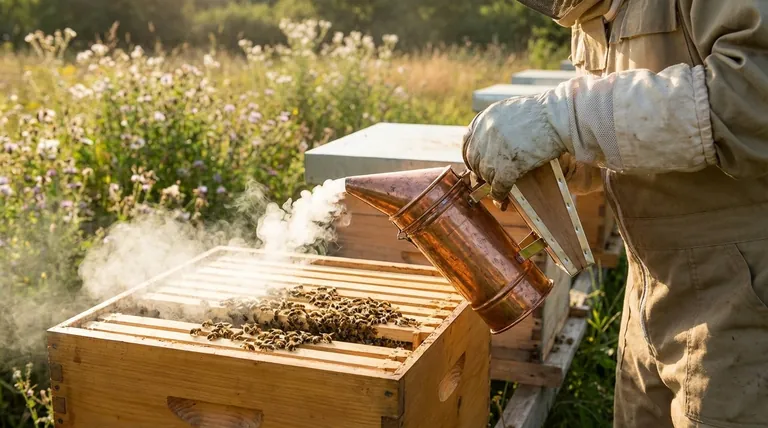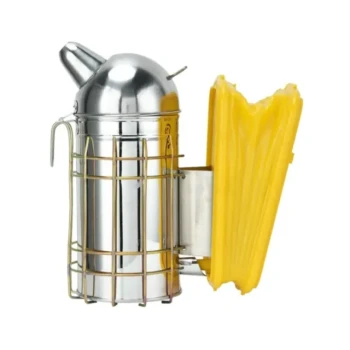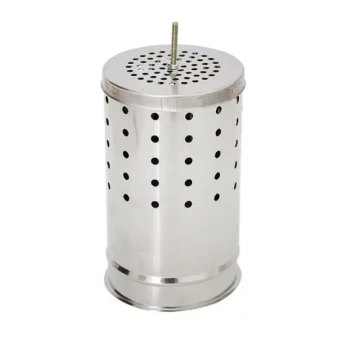At its core, a bee smoker is a tool that leverages honeybee biology to make a colony more docile and manageable. It works by masking the chemical signals bees use to communicate danger and by triggering a natural survival instinct related to forest fires, which distracts them from the beekeeper's presence.
The smoker's effectiveness is twofold: it chemically disrupts the bees' alarm system while simultaneously prompting a biological response that makes them preoccupied with eating honey, rendering them significantly less defensive.

The Two-Fold Calming Mechanism
To understand the smoker, you must understand how a bee colony perceives and reacts to threats. The smoke intervenes in this process on both a chemical and an instinctual level.
Masking the Alarm System
Honeybees communicate threats primarily through alarm pheromones. When a guard bee perceives a danger or is crushed, it releases these chemical signals into the air.
Other bees detect the pheromones with their antennae, which triggers an immediate and coordinated defensive response, leading to more bees becoming agitated and ready to sting.
The thick, cool smoke from a smoker effectively masks these pheromones. It overwhelms the bees' sensory receptors, preventing the alarm signal from spreading throughout the hive. Without the signal, a widespread defensive chain reaction is averted.
Interestingly, a key component of honeybee alarm pheromone smells like banana candy. This is why experienced beekeepers advise against eating bananas before working with a hive, as the scent can be misinterpreted as a threat.
Triggering a Survival Instinct
The presence of smoke triggers a deep-seated, evolutionary response in honeybees. For millions of years, smoke has signaled a nearby wildfire.
When bees sense a potential fire, their primary instinct is not to attack, but to prepare to abandon the hive. Their immediate priority becomes saving the colony and its resources.
To do this, they rush to the honey stores and begin engorging themselves. They consume as much honey as they can carry in preparation for a long journey to establish a new home. A bee with a full belly is physically less able to bend its abdomen to sting and is behaviorally more focused on survival than defense.
Why This Is Critical for Hive Management
Using a smoker is not about harming the bees; it's about creating a safe environment for both the colony and the beekeeper. It turns a potentially dangerous interaction into a calm, productive inspection.
Enabling Safe Inspections
A beekeeper must regularly open the hive to check on the queen, look for signs of disease, and manage space. Without a smoker, lifting the hive cover would be interpreted as a major attack, likely resulting in a massive stinging response.
A few gentle puffs of smoke at the entrance and under the lid pre-empts this defensive reaction. It allows the beekeeper to proceed calmly and efficiently, with a greatly reduced risk of being stung.
Reducing Stress on the Colony
A frantic, defensive response is highly stressful for the colony. It burns through energy reserves and can lead to the death of hundreds of bees, as honeybees die after stinging a mammal.
By keeping the bees calm, the smoker ensures that an inspection is a minor disruption rather than a traumatic event. The colony can return to its normal work of foraging and raising brood much more quickly.
Understanding the Trade-offs
While essential, the smoker is a tool that requires proper technique. Misuse can be ineffective or even detrimental.
The Right Amount of Smoke
The goal is to use cool, white smoke, not hot embers or flames. Too little smoke will be insufficient to mask the pheromones.
Conversely, using far too much smoke can be overly stressful for the bees, contaminate honey with a smoky flavor, and in extreme cases, harm the bees. The aim is to apply just enough to keep the colony's defensive instincts at bay.
Not a Substitute for Gentle Handling
A smoker is an aid, not a magic wand. It must be paired with slow, deliberate movements and gentle handling of hive components. Abrupt motions or crushing bees will still provoke a defensive reaction that even smoke can struggle to contain completely.
Applying Smoke for Your Goal
Your use of the smoker should be adapted to the task at hand.
- If your primary focus is a quick, routine inspection: A few gentle puffs at the entrance and a few more under the lid are often all that is needed to keep the colony calm.
- If your primary focus is a more invasive procedure (like a honey harvest): You may need to apply smoke more consistently throughout the process to maintain a docile atmosphere.
- If you encounter sudden, unexpected aggression: Applying a few extra puffs of smoke can quickly interrupt the alarm pheromone cascade and de-escalate the situation.
Mastering the smoker is a fundamental skill that transforms beekeeping from a confrontation into a cooperative partnership with your colony.
Summary Table:
| Mechanism | How It Works | Benefit for Beekeeper |
|---|---|---|
| Masking Alarm Pheromones | Smoke overwhelms bees' senses, preventing the spread of chemical danger signals. | Prevents defensive chain reactions and reduces stinging risk. |
| Triggering Survival Instinct | Smoke mimics a forest fire, causing bees to engorge on honey instead of defending. | Bees become physically less able to sting and focus on survival. |
Ready to manage your hives with confidence? Equip your apiary with professional-grade smokers and beekeeping supplies from HONESTBEE. We supply commercial apiaries and distributors with durable, effective equipment designed for optimal hive management. Contact our wholesale team today to discuss your needs and enhance your beekeeping operations.
Visual Guide

Related Products
- Premium Traditional Copper Bee Smoker with Bellows
- Stainless Steel Honey Bee Smoker Hive and Honeycomb Smoker for Beekeeping
- Stainless Steel Electric Beehive Smoker for Beekeeping and Bee Keeper Use
- European Stainless Steel Bee Smoker for Honey Bee Hive
- Economy Galvanized Beekeeping Honey Bee Smoker for Wholesale
People Also Ask
- How does water mist work as an alternative to smoke in beehives? A Guide to Safe & Effective Use
- What are some alternatives to using smoke in beekeeping? A Guide to Gentle Hive Management
- What are the main components of a bee smoker? A Guide to Safe and Effective Hive Management
- What is the primary purpose of using smoke in beekeeping? Calm Bees for Safer Hive Management
- What is the purpose of a bee smoker and how should it be used? A Guide to Calm, Safe Hive Inspections



















